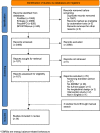Is the transition from primary to secondary school a risk factor for energy balance-related behaviours? A systematic review
- PMID: 37138344
- PMCID: PMC10478069
- DOI: 10.1017/S1368980023000812
Is the transition from primary to secondary school a risk factor for energy balance-related behaviours? A systematic review
Abstract
Objective: The substantial changes in the physical and social environment during the transition from primary to secondary school may significantly impact adolescents' energy balance-related behaviours (i.e. dietary behaviour, sedentary behaviour, sleep behaviour and physical activity (PA)). This is the first review systematically summarising evidence on changes in four energy balance-related behaviours of adolescents across the school transition from primary to secondary school.
Design: For this systematic review, the electronic databases Embase, PsycINFO and SPORTDiscus were searched for relevant studies from inception to August 2021. PubMed was searched for relevant studies from inception to September 2022. Inclusion criteria were: (i) longitudinal studies reporting; (ii) one or more energy balance-related behaviours; and (iii) across the school transition, that is, with measurement(s) during both primary and secondary school.
Setting: Transition from primary to secondary school.
Participants: Adolescents across the transition from primary to secondary school.
Results: Thirty-four studies were eligible. We found strong evidence for an increase in sedentary time, moderate evidence for a decrease in fruit and vegetable consumption, and inconclusive evidence for a change in total, light, and moderate-to-vigorous PA, active transport, screen time, unhealthy snack consumption, and sugar-sweetened beverages consumption among adolescents across the school transition.
Conclusions: During the transition from primary to secondary school, sedentary time and fruit and vegetable consumption tend to change unfavourably. More high-quality, longitudinal research is needed specifically on changes in energy balance-related behaviour across the school transition, especially regarding sleep behaviour. (Prospero registration: CRD42018084799).
Keywords: Adolescents; Dietary behaviour; Obesity; Physical activity; Sedentary behaviour; Sleep behaviour.
Conflict of interest statement
The authors declare that they have no competing interest.
Similar articles
-
School-based physical activity programs for promoting physical activity and fitness in children and adolescents aged 6 to 18.Cochrane Database Syst Rev. 2021 Sep 23;9(9):CD007651. doi: 10.1002/14651858.CD007651.pub3. Cochrane Database Syst Rev. 2021. PMID: 34555181 Free PMC article.
-
Strategies for enhancing the implementation of school-based policies or practices targeting risk factors for chronic disease.Cochrane Database Syst Rev. 2017 Nov 29;11(11):CD011677. doi: 10.1002/14651858.CD011677.pub2. Cochrane Database Syst Rev. 2017. Update in: Cochrane Database Syst Rev. 2022 Aug 29;8:CD011677. doi: 10.1002/14651858.CD011677.pub3. PMID: 29185627 Free PMC article. Updated.
-
Education support services for improving school engagement and academic performance of children and adolescents with a chronic health condition.Cochrane Database Syst Rev. 2023 Feb 8;2(2):CD011538. doi: 10.1002/14651858.CD011538.pub2. Cochrane Database Syst Rev. 2023. PMID: 36752365 Free PMC article.
-
Interventions for promoting habitual exercise in people living with and beyond cancer.Cochrane Database Syst Rev. 2018 Sep 19;9(9):CD010192. doi: 10.1002/14651858.CD010192.pub3. Cochrane Database Syst Rev. 2018. PMID: 30229557 Free PMC article.
-
Physical activity, diet and other behavioural interventions for improving cognition and school achievement in children and adolescents with obesity or overweight.Cochrane Database Syst Rev. 2018 Mar 2;3(3):CD009728. doi: 10.1002/14651858.CD009728.pub4. Cochrane Database Syst Rev. 2018. PMID: 29499084 Free PMC article.
Cited by
-
A participatory needs assessment to map the system dynamics of overweight related behaviours of 10-14-year-old adolescents living in an underserved neighbourhood in Amsterdam, the Netherlands.BMC Public Health. 2025 Jan 25;25(1):324. doi: 10.1186/s12889-025-21498-w. BMC Public Health. 2025. PMID: 39863847 Free PMC article.
-
Factors Affecting Balance Performance in Adolescents.Children (Basel). 2024 Apr 5;11(4):436. doi: 10.3390/children11040436. Children (Basel). 2024. PMID: 38671653 Free PMC article.
-
The effect of successful educational actions in transition from primary to secondary school.PLoS One. 2024 Jun 12;19(6):e0304683. doi: 10.1371/journal.pone.0304683. eCollection 2024. PLoS One. 2024. PMID: 38865381 Free PMC article.
-
Global, regional and national burden of Metabolic dysfunction-associated steatotic liver disease in adolescents and adults aged 15-49 years from 1990 to 2021: results from the 2021 Global Burden of Disease study.Front Med (Lausanne). 2025 Jun 25;12:1568211. doi: 10.3389/fmed.2025.1568211. eCollection 2025. Front Med (Lausanne). 2025. PMID: 40636383 Free PMC article.
References
-
- WHO (2014) Facts and Figures on Childhood Obesity. http://www.who.int/end-childhood-obesity/facts/en/ (accessed September 2020).
-
- Freedman DS, Dietz WH, Srinivasan SR et al. (1999) The relation of overweight to cardiovascular risk factors among children and adolescents: the Bogalusa Heart Study. Pediatrics 103, 1175–1182. - PubMed
-
- Kemper H, Post G, Twisk J et al. (1999) Lifestyle and obesity in adolescence and young adulthood: results from the Amsterdam Growth And Health Longitudinal Study (AGAHLS). Int J Obes 23, S34–S40. - PubMed
-
- Sherry B & Dietz WH (2004) Pediatric Overweight: an Overview. Handbook of Obesity. New York, NY: Marcel Dekker Inc. pp. 117–134.
-
- Tang-Péronard J & Heitmann B (2008) Stigmatization of obese children and adolescents, the importance of gender. Obes Rev 9, 522–534. - PubMed


